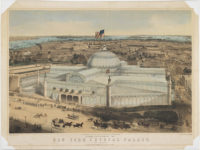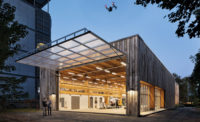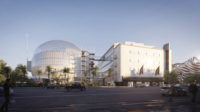A New Exhibition at the Center for Architecture Explores the Design Potential of Scaffolding

An installation designed by Shohei Shigematsu and OMA New York serves as the backdrop for Scaffolding, a new exhibit at the Center for Architecture exploring the varied uses of the ubiquitous structural system.
Photo © Erik Bardin

An installation designed by Shohei Shigematsu and OMA New York serves as the backdrop for Scaffolding, a new exhibit at the Center for Architecture exploring the varied uses of the ubiquitous structural system.
Photo © Erik Bardin

An installation designed by Shohei Shigematsu and OMA New York serves as the backdrop for Scaffolding, a new exhibit at the Center for Architecture exploring the varied uses of the ubiquitous structural system.
Photo © Erik Bardin

An installation designed by Shohei Shigematsu and OMA New York serves as the backdrop for Scaffolding, a new exhibit at the Center for Architecture exploring the varied uses of the ubiquitous structural system.
Photo © Erik Bardin

raumlaborberlin, Gasthof Bergkristall, 2011, Berlin, Germany.
Photo © raumlaborberlin

Charles Lai and Takehiko Suzuki Architects, Temporary Bamboo Shelter, 2015, Duwakot, Nepal.
Photo courtesy Charles Lai and Takehiko Suzuki Architects

Assemble, Folly for a Flyover, 2011, London, United Kingdom.
Photo courtesy Assemble

Hatch Workshop, Workers’ Housing Prototype, 2017, Haryana, India.
Photo courtesy Hatch Workshop

Hatch Workshop, Workers’ Housing Prototype, 2017, Haryana, India.
Photo courtesy Hatch Workshop

helloeverything and SelgasCano, Kibera Hamlets School, 2016, Nairobi, Kenya.
Photo courtesy helloeverything

helloeverything and SelgasCano, Kibera Hamlets School, 2016, Nairobi, Kenya.
Photo courtesy helloeverything

Peter Fattinger, Michael Rieper and students from the Vienna University of Technology, Institute of Architecture and Design, SELFWARE.surface, 2003, Graz, Austria.
Photo © Michael Schuster

Petter Fattinger, Veronika Orso, Michael Rieper and students from the Vienna University of Technology, Institute of Architecture and Design, add on. 20 höhenmeter, 2005, Vienna, Austria.
Photo © Florian Haydn













For urban dwellers around the world, scaffolding is an omnipresent component of the built environment. In New York City, there are an estimated 280 miles of scaffolding on any given day. These fleeting structural systems, oft overlooked given their pervasiveness and disdained for their obstructiveness and crude aesthetic, are the focal point of a new exhibition at the Center for Architecture, aptly titled Scaffolding. The show, which opened on October 2, attempts to break with such negative associations by lending an architectural eye to scaffolding, highlighting the scope of its design potential.
Curated by independent researcher Greg Barton, the exhibit outlines a brief history of scaffolding and draws upon a cross-cultural consortium of case studies, roughly organized around themes of housing prototypes, temporary theatrical spaces, display structures, alternative access, and participatory self-build schemes.
“I’ve always been intrigued by scaffolding’s ability to facilitate very quick structures, usually with the help of people from different backgrounds,” Barton told RECORD. “Considering the fact that New York is filled with scaffolding, I tried to show some of its other uses that are hopefully not just of interest to architects, but to the general public as well.”
The projects on view range from a modular school designed by SelgasCano and helloeverything, first built as a pavilion in 2015 for the Louisiana Museum of Modern Art in Denmark and then later reassembled in Nairobi, Kenya; to the Teatro del Mondo, Aldo Rossi’s temporary wood-and-scaffolding theater constructed for the 1980 Venice Biennale. The show also considers more permanent applications of scaffolding material, such as in the 1994 renovation of the Teatro Oficina in Saõ Paolo, where Lina Bo Bardi and Edson Elito refashioned blue scaffolding tubes for the theater’s seating and technical support.
“Part of my goal was to choose projects that normally wouldn’t be shown together,” said Barton. “Some of them are from large firms, and some are more tactical, but scaffolding is the through-line throughout all.”
Although the case studies form the crux of the exhibit’s theoretical underpinnings, this content competes with the armature onto which the boards of photos, drawings, and text are fastened: an installation of actual scaffolding, designed by Shohei Shigematsu and OMA New York. Described by the AIA New York’s executive director Ben Prosky as one of the most “ambitious installations” to date at the Center, the framework connects the space’s three levels, filling out the first and second floor galleries with a labyrinth of metal tubing.
Given the use of scaffolding in his design for Metropolitan Museum of Art’s 2016 fashion show Manus x Machina, Shigematsu was a fitting choice for the installation. But whereas the scaffolding for the Met’s exhibit was sheathed in transparent scrims and constructed across the museum’s grand Robert Lehman Wing, its application within the Center’s tight West Village quarters is less inventive—it is raw and exposed, and frames narrow paths of circulation, hardly making the case that scaffolding doesn’t necessarily need to be viewed as an impediment. The project boards, some big and some small, are organized at staggering heights across the metal structure; in some cases, exhibit material is printed on scrolls of cloth that drape over the tubes, making the content difficult to view, and confusing the thematic groupings. The occasional inclusion of orange mirrored plates alongside the presentation panels adds more noise to the mixture.
Despite this arrangement, however, what can be taken away from both the installation and Barton’s selection of case studies is a sense of possibility: scaffolding as a building material lends itself to numerous contexts, and the idea to reinvent it in a gallery setting is certainly an intriguing one.
Says president of AIA New York David Piscuskas of the show: “Even amidst the technological leaps that have reshaped our profession, scaffolding retains its integral role in architecture, and this exhibition tells that story.”
Scaffolding is on view at the Center for Architecture through January 18, 2018.

















